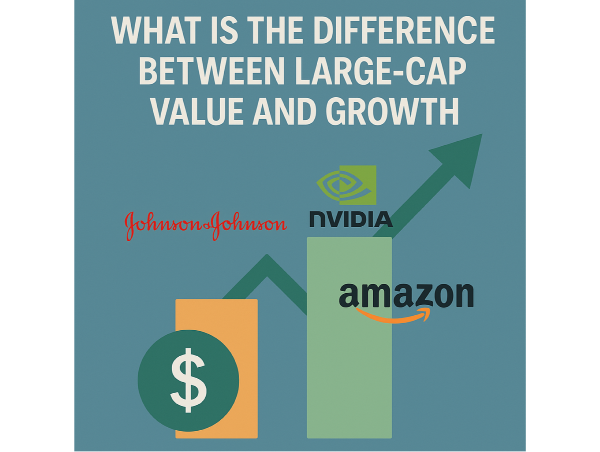Introduction
Large-cap stocks refer to companies with substantial market capitalization, typically exceeding billions of dollars, signifying their stability and market influence. Within this category, value stocks are those trading below their intrinsic worth, often due to temporary market mispricing, while growth stocks represent companies with strong expansion potential and higher valuations based on future earnings expectations. Understanding the differences between these two investment types is essential for investors, as it helps determine suitable portfolio strategies based on risk tolerance, income preferences, and long-term financial goals.
Characteristics of Large-Cap Value Stocks
Large-cap value stocks are defined by their substantial market capitalization, typically exceeding ten billion dollars. These companies are well-established and often dominate their respective industries, providing investors with a sense of stability. Their size allows them to weather economic downturns more effectively than smaller firms, making them a preferred choice for conservative investors seeking reliable returns.
Fundamental indicators play a crucial role in identifying value stocks within the large-cap category. These stocks are often characterized by a low price-to-earnings ratio, a strong price-to-book ratio, and consistent dividend payouts. Investors look for companies with solid financials, including stable revenue streams and profitability, which indicate long-term sustainability. Additionally, these stocks tend to have lower volatility compared to growth stocks, making them attractive for those prioritizing steady income over rapid appreciation.
The balance between growth potential and stability is a key factor in evaluating large-cap value stocks. While these companies may not exhibit the aggressive expansion seen in growth stocks, they often provide dependable returns through dividends and gradual capital appreciation. Their ability to generate consistent earnings and maintain market leadership ensures that they remain valuable assets in diversified portfolios. Investors seeking a mix of security and moderate growth often favor large-cap value stocks for their resilience and predictable performance.
Characteristics of Large-Cap Growth Stocks
Large-cap growth stocks are defined by their substantial market capitalization, typically exceeding ten billion dollars. These companies are recognized for their strong potential to expand revenue and market share, often reinvesting profits into innovation and business development. Their ability to scale operations and capture new markets makes them attractive to investors seeking long-term capital appreciation.
Key financial indicators distinguish large-cap growth stocks from their value counterparts. These stocks often exhibit high price-to-earnings ratios, reflecting investor confidence in future earnings growth. Additionally, they tend to have strong revenue growth rates, supported by strategic acquisitions, technological advancements, or entry into new markets. Companies in this category frequently prioritize reinvestment over dividend payouts, focusing on expansion rather than immediate shareholder returns.
Revenue expansion and innovation are central to the success of large-cap growth stocks. These companies leverage proprietary technology, brand strength, or disruptive business models to maintain a competitive edge. Their ability to introduce new products, optimize operations, and adapt to changing market conditions ensures sustained growth. While these stocks may experience higher volatility, their long-term potential often outweighs short-term price fluctuations.
Investment Strategies for Large-Cap Value Stocks
The buy-and-hold approach is a widely used investment strategy that focuses on long-term stock ownership rather than frequent trading. Investors who adopt this method aim to benefit from the gradual appreciation of large-cap value stocks over time. Research suggests that buy-and-hold investing can be more profitable than active trading, as it minimizes transaction costs and reduces the impact of short-term market fluctuations.
Dividend reinvestment strategies allow investors to compound their returns by automatically reinvesting dividends into additional shares. This approach enhances portfolio growth over time, as reinvested dividends contribute to increased stock holdings without requiring additional capital investment. Companies with a strong history of dividend payments are particularly attractive for this strategy, as they provide consistent income that can be reinvested for long-term gains.
Managing risk through diversification is essential when investing in large-cap value stocks. By spreading investments across different sectors and industries, investors can mitigate losses from downturns in specific markets. Large-cap stocks, due to their stability, often serve as foundational assets in diversified portfolios. Studies indicate that incorporating a mix of value stocks alongside growth stocks can enhance portfolio resilience and improve long-term returns.
Investment Strategies for Large-Cap Growth Stocks
Large-cap growth stocks are primarily sought after for their capital appreciation potential. These companies reinvest earnings into expansion, innovation, and market positioning rather than distributing dividends. Investors favor these stocks for their ability to generate substantial returns over time, particularly in industries with strong growth trajectories. The emphasis on reinvestment allows these companies to scale operations, develop new products, and maintain competitive advantages in their respective sectors.
Timing and market cycle considerations play a crucial role in investing in large-cap growth stocks. These stocks tend to perform well during economic expansions when consumer spending and corporate investments are high. However, they may experience volatility during market downturns, as investors shift toward more stable assets. Understanding macroeconomic trends, interest rate movements, and sector-specific dynamics helps investors determine optimal entry and exit points for growth stocks.
Sector-specific opportunities in growth investing vary based on industry trends and technological advancements. Sectors such as technology, healthcare, and consumer discretionary often house leading large-cap growth stocks due to their innovation-driven business models. Companies in these industries benefit from evolving consumer preferences, regulatory changes, and advancements in technology, making them attractive for long-term investors seeking high-growth potential.
Conclusion
Large-cap value and growth stocks serve distinct roles in investment strategies, each offering unique benefits and risks. While value stocks provide stability, consistent dividends, and lower volatility, growth stocks emphasize expansion, innovation, and higher potential returns. Investors must assess their financial goals, risk tolerance, and market conditions to determine the right balance between these two stock types. By conducting thorough research, leveraging financial metrics, and diversifying portfolios, investors can maximize opportunities while mitigating risks. A well-informed approach to selecting large-cap value or growth stocks ensures long-term financial success and resilience in changing market environments.




























Introduction
Large-cap stocks refer to companies with substantial market capitalization, typically exceeding billions of dollars, signifying their stability and market influence. Within this category, value stocks are those trading below their intrinsic worth, often due to temporary market mispricing, while growth stocks represent companies with strong expansion potential and higher valuations based on future earnings expectations. Understanding the differences between these two investment types is essential for investors, as it helps determine suitable portfolio strategies based on risk tolerance, income preferences, and long-term financial goals.
Characteristics of Large-Cap Value Stocks
Large-cap value stocks are defined by their substantial market capitalization, typically exceeding ten billion dollars. These companies are well-established and often dominate their respective industries, providing investors with a sense of stability. Their size allows them to weather economic downturns more effectively than smaller firms, making them a preferred choice for conservative investors seeking reliable returns.
Fundamental indicators play a crucial role in identifying value stocks within the large-cap category. These stocks are often characterized by a low price-to-earnings ratio, a strong price-to-book ratio, and consistent dividend payouts. Investors look for companies with solid financials, including stable revenue streams and profitability, which indicate long-term sustainability. Additionally, these stocks tend to have lower volatility compared to growth stocks, making them attractive for those prioritizing steady income over rapid appreciation.
The balance between growth potential and stability is a key factor in evaluating large-cap value stocks. While these companies may not exhibit the aggressive expansion seen in growth stocks, they often provide dependable returns through dividends and gradual capital appreciation. Their ability to generate consistent earnings and maintain market leadership ensures that they remain valuable assets in diversified portfolios. Investors seeking a mix of security and moderate growth often favor large-cap value stocks for their resilience and predictable performance.
Characteristics of Large-Cap Growth Stocks
Large-cap growth stocks are defined by their substantial market capitalization, typically exceeding ten billion dollars. These companies are recognized for their strong potential to expand revenue and market share, often reinvesting profits into innovation and business development. Their ability to scale operations and capture new markets makes them attractive to investors seeking long-term capital appreciation.
Key financial indicators distinguish large-cap growth stocks from their value counterparts. These stocks often exhibit high price-to-earnings ratios, reflecting investor confidence in future earnings growth. Additionally, they tend to have strong revenue growth rates, supported by strategic acquisitions, technological advancements, or entry into new markets. Companies in this category frequently prioritize reinvestment over dividend payouts, focusing on expansion rather than immediate shareholder returns.
Revenue expansion and innovation are central to the success of large-cap growth stocks. These companies leverage proprietary technology, brand strength, or disruptive business models to maintain a competitive edge. Their ability to introduce new products, optimize operations, and adapt to changing market conditions ensures sustained growth. While these stocks may experience higher volatility, their long-term potential often outweighs short-term price fluctuations.
Investment Strategies for Large-Cap Value Stocks
The buy-and-hold approach is a widely used investment strategy that focuses on long-term stock ownership rather than frequent trading. Investors who adopt this method aim to benefit from the gradual appreciation of large-cap value stocks over time. Research suggests that buy-and-hold investing can be more profitable than active trading, as it minimizes transaction costs and reduces the impact of short-term market fluctuations.
Dividend reinvestment strategies allow investors to compound their returns by automatically reinvesting dividends into additional shares. This approach enhances portfolio growth over time, as reinvested dividends contribute to increased stock holdings without requiring additional capital investment. Companies with a strong history of dividend payments are particularly attractive for this strategy, as they provide consistent income that can be reinvested for long-term gains.
Managing risk through diversification is essential when investing in large-cap value stocks. By spreading investments across different sectors and industries, investors can mitigate losses from downturns in specific markets. Large-cap stocks, due to their stability, often serve as foundational assets in diversified portfolios. Studies indicate that incorporating a mix of value stocks alongside growth stocks can enhance portfolio resilience and improve long-term returns.
Investment Strategies for Large-Cap Growth Stocks
Large-cap growth stocks are primarily sought after for their capital appreciation potential. These companies reinvest earnings into expansion, innovation, and market positioning rather than distributing dividends. Investors favor these stocks for their ability to generate substantial returns over time, particularly in industries with strong growth trajectories. The emphasis on reinvestment allows these companies to scale operations, develop new products, and maintain competitive advantages in their respective sectors.
Timing and market cycle considerations play a crucial role in investing in large-cap growth stocks. These stocks tend to perform well during economic expansions when consumer spending and corporate investments are high. However, they may experience volatility during market downturns, as investors shift toward more stable assets. Understanding macroeconomic trends, interest rate movements, and sector-specific dynamics helps investors determine optimal entry and exit points for growth stocks.
Sector-specific opportunities in growth investing vary based on industry trends and technological advancements. Sectors such as technology, healthcare, and consumer discretionary often house leading large-cap growth stocks due to their innovation-driven business models. Companies in these industries benefit from evolving consumer preferences, regulatory changes, and advancements in technology, making them attractive for long-term investors seeking high-growth potential.
Conclusion
Large-cap value and growth stocks serve distinct roles in investment strategies, each offering unique benefits and risks. While value stocks provide stability, consistent dividends, and lower volatility, growth stocks emphasize expansion, innovation, and higher potential returns. Investors must assess their financial goals, risk tolerance, and market conditions to determine the right balance between these two stock types. By conducting thorough research, leveraging financial metrics, and diversifying portfolios, investors can maximize opportunities while mitigating risks. A well-informed approach to selecting large-cap value or growth stocks ensures long-term financial success and resilience in changing market environments.